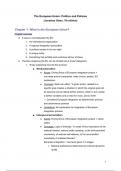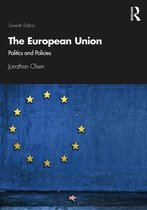The European Union: Politics and Policies
(Jonathan Olsen, 7th edition)
Chapter 1: What is the European Union?
Chapter overview
● 5 ways to conceptualize the EU:
1. An international organization
2. A regional integration association
3. A political system in its own right
4. A unique entity
5. Something that exhibits and combines all four of these
● Theories analyzing the EU can be divided into 2 broad categories:
1. Those explaining how the EU evolved
■ Neofunctionalism
● Actors: Driving force of European integration project =
non-state actors (companies, trade unions, parties, EU
institutions)
● Concepts: Spill-over effect: “A given action, related to a
specific goal creates a situation in which the original goal can
be assured only by taking further actions, which in turn create
a further condition and a need for more, and so forth”
→ Considers European integration as deterministic process
and autonomous process
● Limitations: No explanation for stagnation of European
integration process
■ Intergouvernementalism
● Actors: Driving force of European integration project = nation
states
● Concepts: Logic of diversity: “In areas of key importance to the
national interest, nations prefer certainty, or the self-controlled
uncertainty, of national self-reliance, to the uncontrolled
uncertainty of untested blunder”
European integration = two-level game in 3 stages
1. National preferences determined by internal dynamics
of MS
1
, 2. Manifestation of integration depends on relative power
of MS
3. Institutionalization through EU institutions that
execute/implement deals between MS
● Limitations: myopic towards own interests of non-state actors +
no explanation for MS acting against own interests
■ Long dominated by scholars of international relations
2. Those explaining what it has become
■ The province of scholars of comparative politics
■ EU as a political system with its own institutions, processes,
procedures, and policies
■ Multi-level governance
● What is the European Union?
○ Much more than a conventional international organization
○ Less than a European superstate
○ Now it is seen as a political system in its own right
○ No single generally accepted theoretical framework
The role of the state
● Four possible approaches to the study of the EU (Ben Rosamond):
1. As an international organization, tying it to the substantial literature on such
organizations
2. As an example of regionalism in the global economic system and compare it
to other regional blocs
3. As an example of the dynamics of policy-making in an attempt to better
understand the crafting of interstate policy and how it is influenced by
actors interested in the use of power
4. Purely on its own terms, as a unique organization that emerged out of a
unique set of circumstances
● Rosamond’s list overlooked a critical fifth option:
○ Trying to understand the EU as a political system in its own right, and
comparing its structure and operating principles with those of conventional
national political systems
● A state is usually defined as a legal and physical entity that:
1. Operates within a fixed and populated territory
2. Has authority over that territory
3. Is legally and politically independent
2
, 4. Is recognized by its people and by other states
● The 1648 Peace of Westphalia
○ Brought an end to 2 European wars
○ Gave a new permanence to the idea of borders and sovereignty
● State has many critics
○ Divides humans rather than uniting them
○ Encouraging people to place sectional interests above the broader interests
of humanity
○ Identification with states is often associated with nationalism
■ Nationalism can lead to internal instability, a belief in national
superiority, ethnocentrism, racism, genocide, and war within and
between states
● Criticism of the state contributed to the growth of international cooperation
● International organizations = bodies that promote voluntary cooperation and
coordination between or among their members but have neither autonomous powers
nor the authority to impose their rulings on their members
● Intergovernmental organizations = consist of representatives of national
governments and promote voluntary cooperation among those governments (for
example United Nations)
● International nongovernmental organizations = consist of individuals or the
representatives of private associations rather than states
● Integration involves the surrender, transfer, or pooling of sovereignty (The rights of
jurisdiction that states have over their people and territory and that cannot legally be
challenged by any other authority)
How did the EU evolve?
● Federalism was based on the idea that states had lost their political rights because
they could not guarantee the safety of their citizens and that political integration
would beget economic, social, and cultural integration.
● 1946: The European Union of Federalists was created
○ All they were able to agree on was the creation of the Council of Europe,
which has the more modest goal of intra-European cooperation
● Mitrany saw nationalism as the root of conflict and argued that states should be
bound together by a network of international agencies that built on common interests
and had authority in functionally specific fields
● Ernst Haas and Leon Lindberg: adaptation of Mitrany’s theories as neo-functionalism
● Lindberg: spillover
3
, ○ Cooperation in one sphere would spill over to cooperation in other spheres,
thus leading to greater economic, policy, and political integration of sovereign
states
● Examples that illustrate how spillover could explain the evolution of EU integration:
○ Functional spillover: implies that economies are so interconnected that if
states integrate one sector of their economies, it will lead to the integration of
other sectors
○ Technical spillover: implies that disparities in standards will cause states to
rise to the level of those with the tightest regulations
○ Political spillover: implies that once different functional sectors are
integrated, interest groups will switch from trying to influence national
governments to trying to influence regional institutions, which will encourage
their attempt to win new powers for themselves
● Joseph Nye: regional integration involved an “integrative potential” that depended on
several conditions:
○ The economic equality or compatibility of the states involved
○ The extent to which the elite groups that control economic policy in the
member states think alike and hold the same values
○ The extent of interest group activity, or pluralism
○ The capacity of the member states to adapt and respond to public demands,
which depends in turn on levels of domestic stability and the capacity, or
desire, of decision-makers to respond
● Neofunctionalism dominated studies of European integration during the 1950s and
1960s but briefly fell out of favor during the 1970s → explanation:
○ The failure of the European Commission to provide the kind of leadership that
was vital to the idea of neo-functionalism
○ The theory of spillover needed more elaboration
● Stanley Hoffman: response to neo-functionalism → intergovernmental
What has the EU become?
● On the one hand: EU has some qualities of an international organization:
○ Its members are nation states
○ Membership is voluntary
○ The balance of sovereignty lies with the member states
○ Decision-making is consultative
○ The procedures used are based on consent rather than compulsion
● On the other hand: the EU also has some of the qualities of a state:
4





